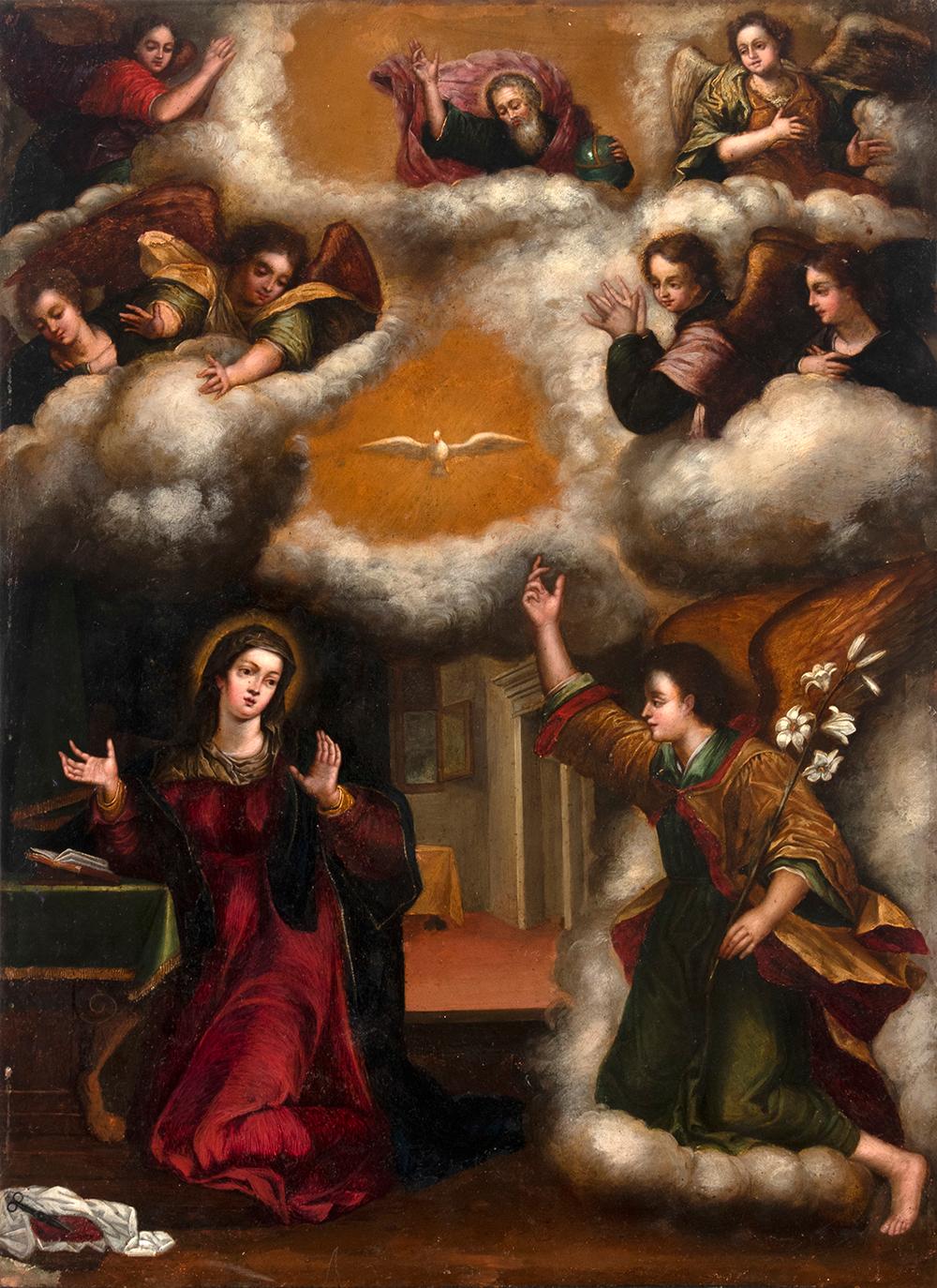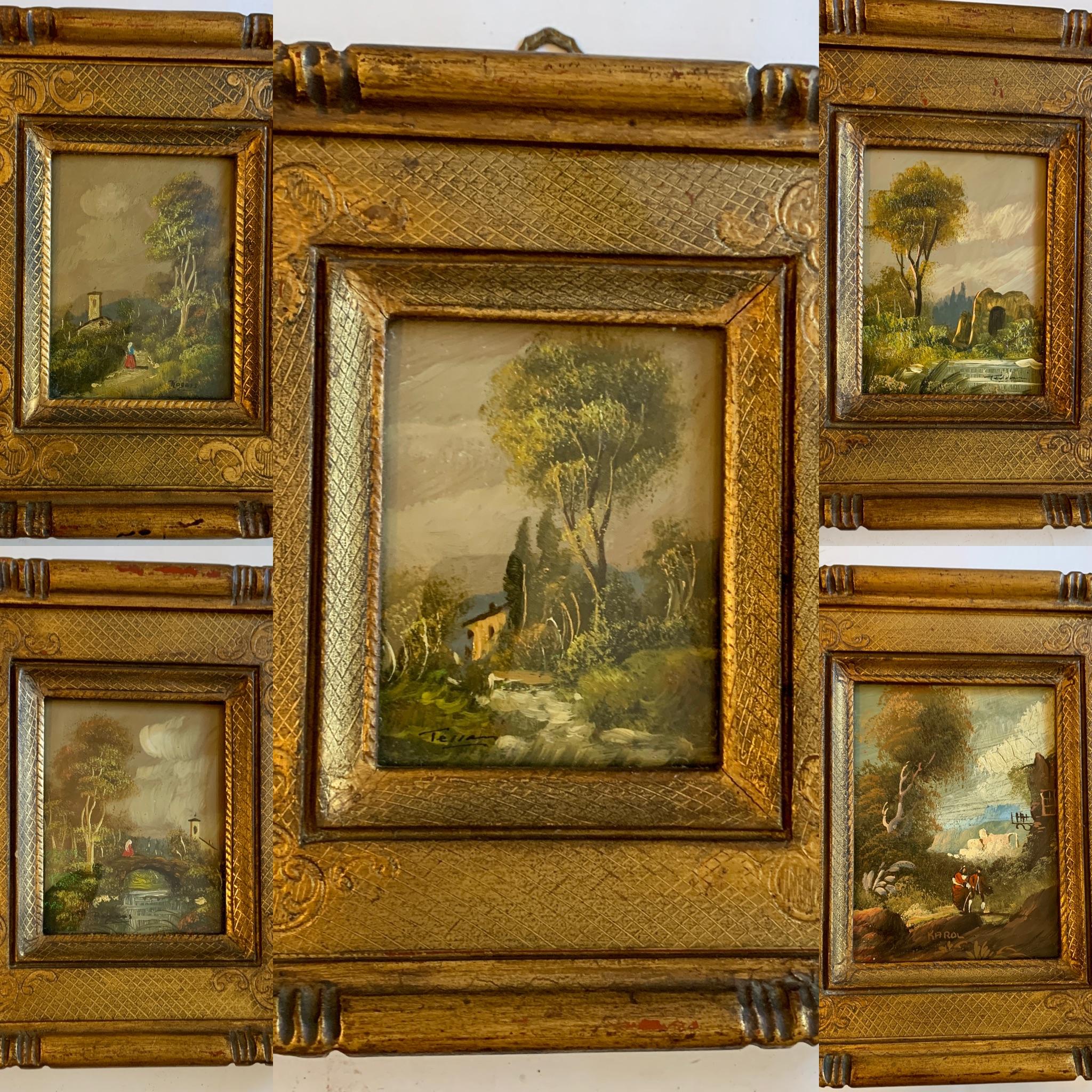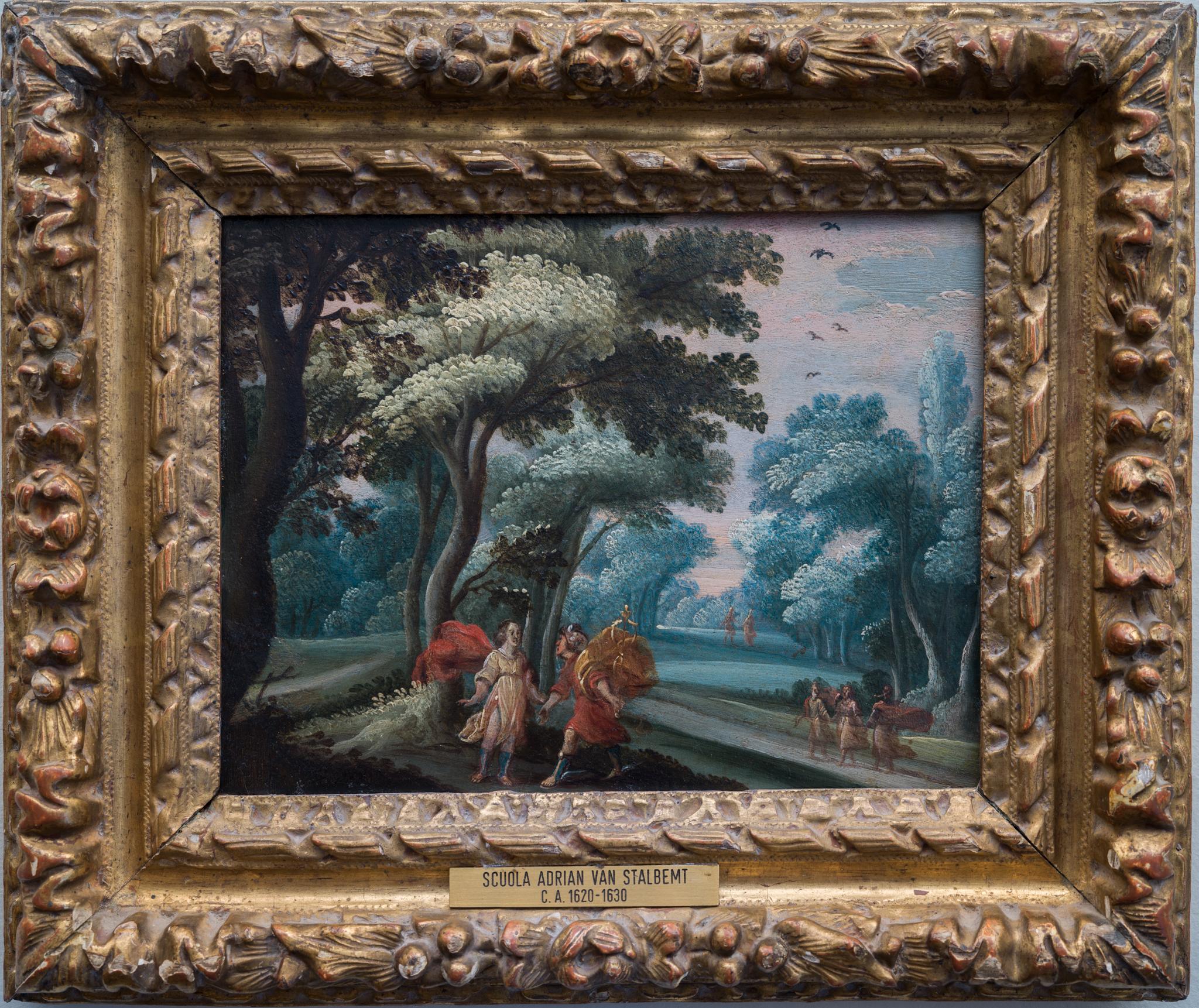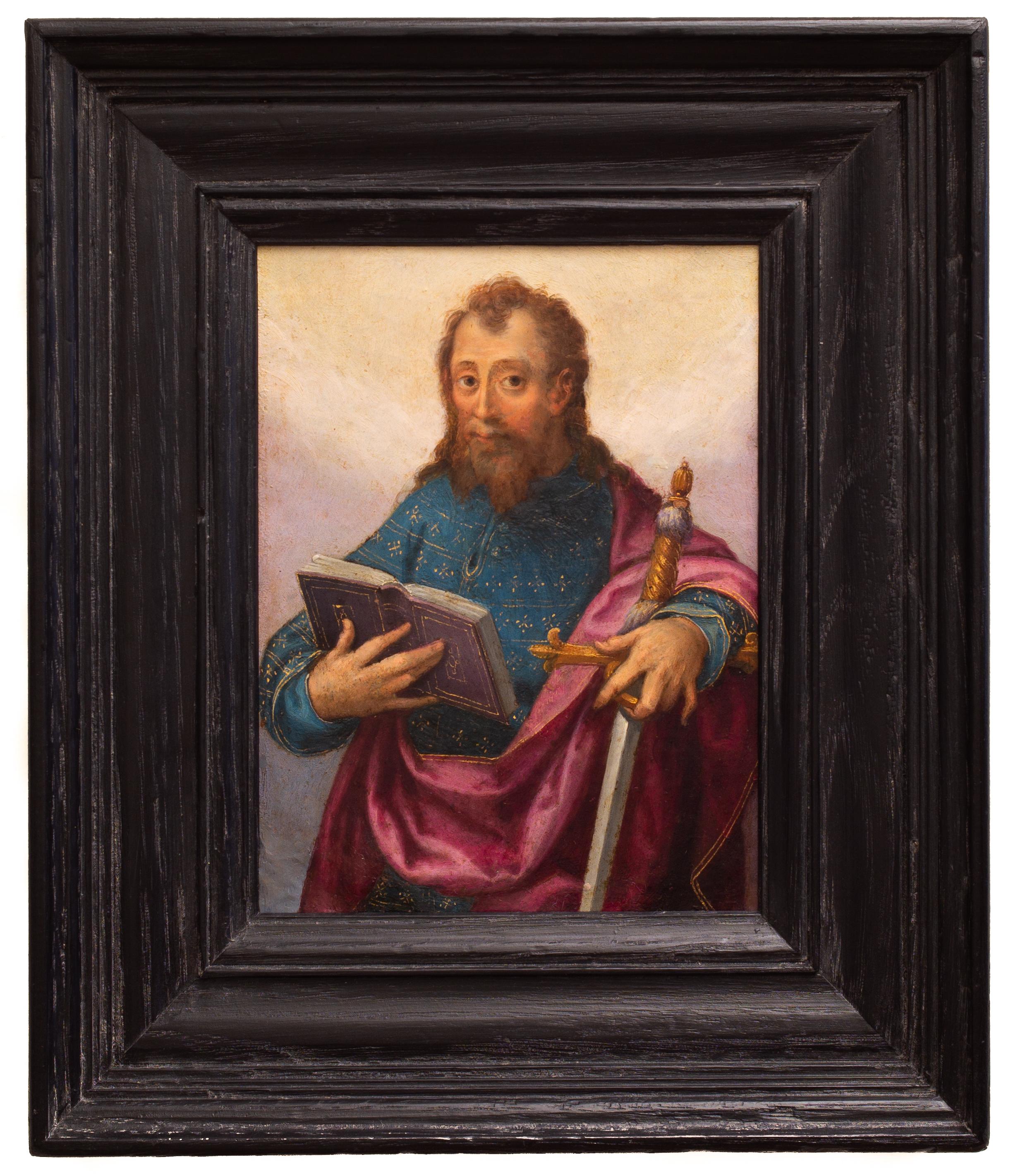Items Similar to Adoration of the Shepherds, attributed to Louis de Caullery, early 17th century
Want more images or videos?
Request additional images or videos from the seller
1 of 11
Adoration of the Shepherds, attributed to Louis de Caullery, early 17th centurycirca 1620
circa 1620
About the Item
Adoration of the Shepherds
Attributed to Louis de Caullery (1580-1622)
17th century Antwerp School, circa 1620
Oil on copper: h. 54 cm (21.26 in.), w. 72 cm (28.35 in)
A 17th century Louis XIV period giltwood frame carved with flowers, foliage and scrolls.
Framed: h. 69 cm (27.16 in), w. 87 cm (34.25 in.)
Illustrating an episode in the life of Christ, the adoration of the shepherds, our painting is part of a series of works associated with the birth of Jesus and is one of the few biblical subjects treated by the Antwerp painter, Louis de Caullery. Rather specialized in feasts and genre scenes, Louis de Caullery, following the example of his contemporaries, also devoted himself to sacred painting, favouring two opposing subjects in his body of work: the Nativity and the Crucifixion. Generally, he illustrates very few scenes from the Old Testament.
Our painting highlights the moment after Jesus' birth in the stable. The shepherds were the first to be informed of the event and arrived on the scene long before the Magi.
The painter places the Virgin Mary in the centre with a halo on her head, dressed in a blue cloak showing the improvised cradle of the baby Jesus, while an angel bows before him. The shepherds gather around the Virgin and Jesus, spread out on either side, some kneeling in veneration before Christ. The painter places Saint Joseph with the ox in the background among the spectators.
In heaven a whole assembly of cherubs sings a sacred concert proclaiming the birth of the Saviour. A celestial light pierces the darkened sky to illuminate the scene.
The harmony of the warm-toned colours is broken by the icy blue and green clothing of some figures, bringing contrasts to the composition.
The finesse of the brush in the rendering of the fabrics accentuates the folds of the wrinkled clothes and brings volume and depth. Admirably constructed, the composition is enriched by numerous figures on earth and in the heavens, by numerous superimposed planes.
Related works:
- Louis de Caullery's studio, Musée des Beaux Arts d'Orléans
- Louis de Caullery's studio, Musée Vivant Denon in Chalon-sur-Saône
- Louis de Caullery, signed and dated 1621, private collection, listed in the RKD database under the number 1001086704
- Attributed to:Louis de Caullery (1580 - 1621, Belgian, French)
- Creation Year:circa 1620
- Dimensions:Height: 27.16 in (68.99 cm)Width: 34.25 in (87 cm)
- Medium:
- Movement & Style:
- Period:Early 17th Century
- Condition:Very good original condition, cleaned and revarnished by our professionnal art restorer.
- Gallery Location:PARIS, FR
- Reference Number:1stDibs: LU2433213627582
About the Seller
No Reviews Yet
Vetted Seller
These experienced sellers undergo a comprehensive evaluation by our team of in-house experts.
1stDibs seller since 2023
7 sales on 1stDibs
Typical response time: 1 hour
- ShippingRetrieving quote...Ships From: PARIS, France
- Return PolicyA return for this item may be initiated within 3 days of delivery.
More From This SellerView All
- 17th c. Flemish - Landscape with Flight to Egypt - Antwerp circa 1630Located in PARIS, FRLANDSCAPE WITH FLIGHT TO EGYPT, JASPER VAN DER LANEN (ANTWERP, 1585 - 1634) 17TH CENTURY FLEMISH SCHOOL ANTWERP CIRCA 1630 Oil on copper, dimensions: h. 10.23 in, w. 14.96 in Flemish style frame in ebonized wood adorned with wavy moldings and wood veneer. Framed dimensions: h. 17.32 in, w. 21.65 in Provenance: Philips auction...Category
Early 17th Century Old Masters Figurative Paintings
MaterialsCopper
- Allegory of Summer, workshop of Hendrick Van Balen 17th c. Antwerp schoolBy Hendrick van BalenLocated in PARIS, FRAllegory of summer, personified by Ceres Workshop of Hendrick Van Balen Antwerp School, early 17th century. Oil on copper, Dimensions: h. 52 cm, l. 40cm Antic giltwood frame Framed dimensions: h. 74 cm, l. 60cm Very good condition Our delicately painted work is part of the pictorial tradition that is both allegorical and mythological in vogue in Antwerp, whose leaders are Jan Brueghel the Younger and Hendrick Van Balen. Numerous works emerging from their workshops illustrate mythological subjects, the seasons, the elements, the senses or intertwining the lush landscapes, animals and gods of Olympus. At the heart of a green landscape dominated in its center by a generous apple tree, the beautiful Ceres, partially dressed in a large blue drape, is wearing a crown of ears of wheat, her symbol of the goddess of the earth and harvests. She holds the sickle in her right hand and carries sheaves of wheat. To her right a nymph holds the cornucopia while puttis pick and offer flowers. In the foreground are the summer fruits: figs, cherries, apples and lemons. A squirrel munching on cherries symbolizes toil and foresight, themes that are echoed in the work of the harvesters on the wheat fields in the background. The background is composed of vegetation, on the right a wild rose bush with its branches erect against a tree trunk, in the center of the trees with silvery green foliage. Our painter, a student of Hendrick Van Balen, finds his inspiration in the works of the master such as this nymph in yellow drapery seen from behind, one of the figures which accompanies many of the master's paintings. The elegant gestures, the flesh...The indisputable influence of Jan Brueghel the Younger is revealed in the treatment of trees and flowers, wild roses, tulips as well as in the still life with the squirrel in the foreground. The craze for this type of virtuoso painting where the mythological figures are only a pretext to better illustrate the landscape and plant species surrounding them, then generated orders from all over Europe. Hendrick Van Balen, Flemish painter, born and died in Antwerp (1575-1632). A student of Adam Van Noort, he entered the guild of Saint-Luc in 1593, later trained in Italy and was Van Dyck's first master. He often painted small characters taken from scenes from the Bible or classical mythology, on paintings in which Josse de Momper...Category
Early 17th Century Old Masters Figurative Paintings
MaterialsCopper
- The Triumph of the Infant Bacchus, workshop of H. Van Balen, 16th c. AntwerpBy Hendrick van BalenLocated in PARIS, FRThe Triumph of the Infant Bacchus, Workshop of Hendrick Van Balen (1575-1632) Antwerp, c.1630 Oil on copper, h. 28 cm (11.02 in), w. 35 cm (13.78 in) A large Roman 17th century golden painted frame Framed: h. 52 cm (20.47 in.), w. 58 cm (22.83 in) Our finely painted work depicts The Triumph of the Bacchus as a young boy and is one of the most popular mythological subjects in Antwerp at the beginning of the 17th century. Feasting, wine and fun are the themes that constantly appeal to the public. Thus unfolds before our eyes on our painting the procession composed of nymphs, baccantes, fauns, satyrs and children, their bodies naked, partially covered with brightly coloured draperies that help to brighten up the parade. Playing various instruments, dancing and drinking, while carrying vases and poles adorned with grapevines, participants to the rhythm of a noisy brass band make their way to an ancient temple standing on the right. The exaggerated gestures convey to us the frenzy of the excited crowd. The Child Bacchus follows the joyous procession, carried by satyrs and nymphs, crowned with ivy and joyfully raising a cup of wine. In the foreground, the drunken participants leave the procession, the children on the left and the group of bacchantes and satyrs on the right are resting among various objects scattered at their feet: cups, vases, ewers bear witness to the festivities in progress. In the background, a hilly landscape stretches out on the horizon, a semblance of calm that contrasts with the bustle of the foreground. The artist strives to multiply the many details, whether it be figures, costumes, flowers or vegetation, in order to demonstrate his know-how and the perfection of his execution. The acidulous palette with fresh and varied colours is characteristic of Hendrick Van Balen's works. There are several versions identical to ours with similar dimensions painted by Hendrick Van Balen and his workshop. Related works: • Koller Auction, Zurich, 21/09/2007, oil on copper, 28,5 x 37,4 cm. • Staatliche Kunsthalle, Karlsruhe, Inv. N° 809 (oil on copper, 40 x 53,5 cm) • Auktionshaus für Altertümer Glückselig, Vienne, 10/05/1932, ( oil on copper, 34 x 42 cm) • Gemäldegalerie of Pommersfelden, Schloss Weissenstein, oil on panel, 47 x 64 cm Hendrick Van Balen, Flemish painter, born and died in Antwerp (1575-1632). A pupil of Adam Van Noort, he entered the Guild of St. Luke in 1593, later trained in Italy and was Van Dyck's first teacher. He often painted small figures taken from scenes from the Bible or classical mythology, on paintings whose backgrounds and landscapes were painted by Josse de Momper...Category
17th Century Old Masters Figurative Paintings
MaterialsCopper
- A 17th c. Italian school, Capriccio with the Colosseum, circle of V. CodazziLocated in PARIS, FRA capriccio with the Colosseum in Roma 17th century Italian school Circle of Viviano Codazzi (1604-1670) Oil on canvas Dimensions: h. 35.43 in, w. 51.18 in Modern 17th century style ...Category
17th Century Old Masters Landscape Paintings
MaterialsCanvas, Oil
- Rest on the Flight into Egypt - Attributed to Pieter Van Avont - 17th c. FlemishBy Pieter van AvontLocated in PARIS, FRRest during the Flight into Egypt - The Virgin and Child with St. John the Baptist and the angels in a Landscape. Attributed to Pieter Van Avont (1600-1652) 17th century Antwerp School, circa 1630 Oil on oak panel, Dimensions: h. 38 cm, w. 50 cm (14.96 in x 19.68 in) Flemish style frame in ebonized and moulded wood Framed: h. 56 cm, w. 68.5 cm (22.04 in. x 26.97 in.) In the heart of a lush wooded landscape, the Virgin with Jesus rests in a green clearing accompanied by Saint John the Baptist and the cherubs. Seated to the left of the composition, the Virgin Mary holds the Child on her lap; the little Saint John the Baptist wearing the camel-skin tunic (his attribute) stands before Jesus to exchange a few caresses. On the right, the couple of cherubs are playing with the lamb of Saint John the Baptist, bringing a jovial character to the scene. A pair of gardening putti on the left pick flowers to bring bouquets to the Virgin and Jesus. Spring flowers such as tulips, daffodils and anemones that grow abundantly around them and enrich the composition with their shimmering colors. A lush rose bush blooms to the left of the figures offering delicate roses. (The rose is the flower associated with the Virgin Mary, who is the "mystical rose," the one that does not bear the "thorn of sin") At the feet of the Virgin are bunches of grapes (symbol of the future passion of Christ) as well as apples (symbol of the original fall of Man but also of the Redemption in Christ) In the foreground we find a wicker basket filled in profusion with beautiful flowers and guinea pigs nibbling on the blades of grass. In a cleverly arranged disorder, these elements of the still life with their strong symbolic power accentuate the religious theme, but are also an opportunity for the artist to demonstrate his know-how in the still life genre that is gaining momentum in Antwerp. The landscape behind the figures consists of a large tree with a twisted trunk and a luminous opening to the horizon placed on the right. We see Saint Joseph arriving with a donkey, a small reminder from the artist that the composition is associated with the episode of Rest during the flight into Egypt. The calm expanse of this bucolic forest opening onto the luminous distance, with its profusion of symbolic flowers and fruits, is particularly suited to this sacred scene. The theme of Jesus' sacrifice and his tragic fate is mitigated by cherubs who play with innocence and carelessness in the face of the fragility of life symbolized by cut flowers. The great mastery of the painter is manifested by the finesse of the drawing enhanced by the delicacy in the application of the brushstrokes bringing a multitude of details. The richness of the whole is exacerbated thanks to the choice of colours, this varied palette is an undeniable asset of our work. The virtuosity of our artist lies in his versatility, as much concerned with the success of the landscape and flowers as with the modelling of his figures. The cherubs with their naked bodies are gracefully illuminated by warm colours with subtle shadows, while the still life is rendered with astonishing realism, both in the precision of the drawing and in the countless shades of the flowers. There are several compositions similar to ours, of which below are the closest versions: • Sale, Jean-Claude Anaf et Associés, Lyon, 08/02/1998, attributed to Pieter Van Avont, oil on panel, h. 48 cm, l. 71 cm (recorded on RKD n° 31451). Comment: identical composition, only St Joseph with the donkey is different) • Christie's New York sale, 29/01/1998, Pieter Van Avont, oil on copper, h. 23.8 cm, w. 24.8 cm • Dorotheum sale, Vienna, 25/04/2017, Pieter Van Avont and Jan Breughel II, oil on copper, h .26 cm, w. 39 cm • Hermitage Museum, Saint Petersburg, Russia, Pieter Van Avont, oil on panel, h. 50.5 cm, w. 71.7 cm Peter van Avont, Flemish painter (Mechelen, 1600 - Antwerp. 1652) Born in Mechelen, he is mentioned in 1620 as a member of the painters' guild of his hometown. He left in 1 622 for Antwerp, where he was also a member of the guild. He collaborated with many painters, including Jan Brueguel the Younger, David Vinckboons, Lucas van Uden...Category
17th Century Old Masters Landscape Paintings
MaterialsOak, Oil
- Cercle of Ambrosius Francken, Adoration of the shepherds, 17th century AntwerpLocated in PARIS, FRAdoration of the shepherds, Cercle of Ambrosius Francken, Early 17th century Antwerp school Oil on oak panel: h. 55 cm, w. 43 cm (21.65 in x 16.93 in) 17th c. ebonized and moulded f...Category
Early 17th Century Old Masters Figurative Paintings
MaterialsOil, Wood Panel
You May Also Like
- The Adoration of the Magi by Joseph van BredaelLocated in New Orleans, LAJoseph van Bredael 1688-1739 Flemish The Adoration of the Magi Oil on copper Painted on copper and exhibiting an exquisite luminosity, this exceptional painting...Category
Late 17th Century Old Masters Figurative Paintings
MaterialsCopper
- La Sagrada FamiliaLocated in Miami, FLJosé de Páez (1727-1790) Colonial Mexican painting from the 18th century. Conserved in excellent condition. "La Sagrada Familia" Oil on Copper 8 x 12 in ...Category
18th Century Old Masters Figurative Paintings
MaterialsCopper
- La AnunciaciónLocated in Miami, FLAnonymous Artist "La Anunciación" from the 18th Century. Oil on Copper 21.5 x 15.7 inches Perfect Condition It represents the moment when Mary accepts the divine designs transmitted by the archangel Saint...Category
18th Century Old Masters Figurative Paintings
MaterialsCopper
- Five mid 20th century Italian oil landscapes with figures, castles, ChurchsLocated in Woodbury, CTA very interesting set of five mid-20th-century Italian oils on copper. All five are classical landscape subjects and are signed Roger, though we don't know which artist with the n...Category
1950s Old Masters Landscape Paintings
MaterialsCopper
- A 17th Century Mythological SceneLocated in Stockholm, SEThis small yet captivating painting, crafted on a copper plate, dates back to the mid-1600s and was created by a Flemish artist. Subject Matter: The central figure in the artwork is Mercury, easily identified by his symbolic attributes like winged sandals, petasus, and caduceus. Beside him is a likely female figure, characterized by her attire and absence of weaponry. The depicted scene could represent two mythological tales: Mercury and Calypso: This interpretation suggests the artwork shows the moment Zeus sends Mercury to Calypso's island, Ogygia. Mercury is there to order Calypso to release Ulysses, whom she saved from a shipwreck but kept captive. The lush, wooded background and the three distant figures could hint at Ulysses' farewell to Calypso. Mercury and Herses: Another interpretation could be a scene from the love story of Mercury and Herses. The background figures might symbolize the sisters returning from a procession, while the forefront could be the initial meeting between Mercury and the most beautiful sister, Erse. Artistic Inspiration: The painting's landscape and setting are heavily influenced by the early 17th century Northern European art trends, especially the works of Jan Brueghel the Elder. However, the artwork stands apart with its unique luminescence in detailing and a distinctive approach to depicting figures. While the exact origin and artist remain somewhat mysterious, the style and treatment of light hint towards works close to Josse de Momper...Category
Mid-17th Century Old Masters Figurative Paintings
MaterialsCopper
- St Paul With Sword and Book, Mannerist School, Oil on CopperLocated in Stockholm, SEMannerism, derived from the Italian term "maneria," which simply means "style," was an artistic movement that emerged in the later years of the Italian High Renaissance, around 1520, and extended into the early 17th century. It is often referred to as the "stylish style" due to its emphasis on self-conscious artifice rather than realistic depiction. Historians debate whether Mannerism should be classified as a style, a movement, or a period. In contrast to the harmonious ideals embraced by renowned artists such as Raphael, Michelangelo, and Leonardo da Vinci, Mannerist painters took a step further and created compositions that were almost bizarre. They introduced fresh color schemes, elongated proportions, and exaggerated anatomy of figures, portraying them in convoluted and serpentine poses. These artists skillfully exhibited their techniques and abilities, aiming to evoke a sense of sophisticated elegance. Among the notable Mannerist painters are Jacopo da Pontormo, Bronzino, Lavinia Fontana...Category
17th Century Old Masters Figurative Paintings
MaterialsCopper
Recently Viewed
View AllMore Ways To Browse
The Shepherd
The Ox
17th Century Dated
17th Century Copper
17th Century Louis Xiv
17th Century Fabric
Life Of Christ
Antique Heaven
17th Century Flower Painting
17th Century Genre
Louis In The Sky
Shepherd Antique Painting
The Crucifixion
Paintings Of Cherubs
17th Century Saint Paintings
Before Christ
Painting With Cherubs
Art The Adoration





